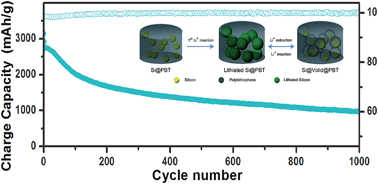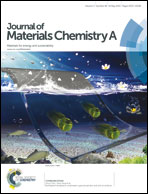Enabling a high capacity and long cycle life for nano-Si anodes by building a stable solid interface with a Li+-conducting polymer†
Abstract
Great efforts have been devoted to developing nano-Si anodes for next-generation lithium ion batteries (LIBs); however, the reversible capacity and cycling stability of all Si anodes developed so far still need to be improved for battery applications. In this work, we propose a new strategy to develop a cycling-stable Si anode by embedding nano-Si particles into a Li+-conductive polymer matrix, in which a stable Si/polymer interface is established to avoid the contact of the Si surface with the electrolyte and to buffer the volume change of the Si lattice during cycles, thus promoting the capacity utilization and long cycle life of nano-Si particles. The nano-Si/polybithiophene composite synthesized in this work demonstrates a high Li-storage capacity of >2900 mA h g−1, a high-rate capability of 12 A g−1 and a long-term cyclability with a capacity retention of >1000 mA h g−1 over 1000 cycles, possibly serving as a high capacity anode for lithium battery applications. In addition, the fabrication technique for this type of composite material is facile, scalable and easily extendable to other Li-storable metals or alloys, opening up a new avenue for developing high capacity and cycling-stable anodes for advanced Li-ion batteries.


 Please wait while we load your content...
Please wait while we load your content...